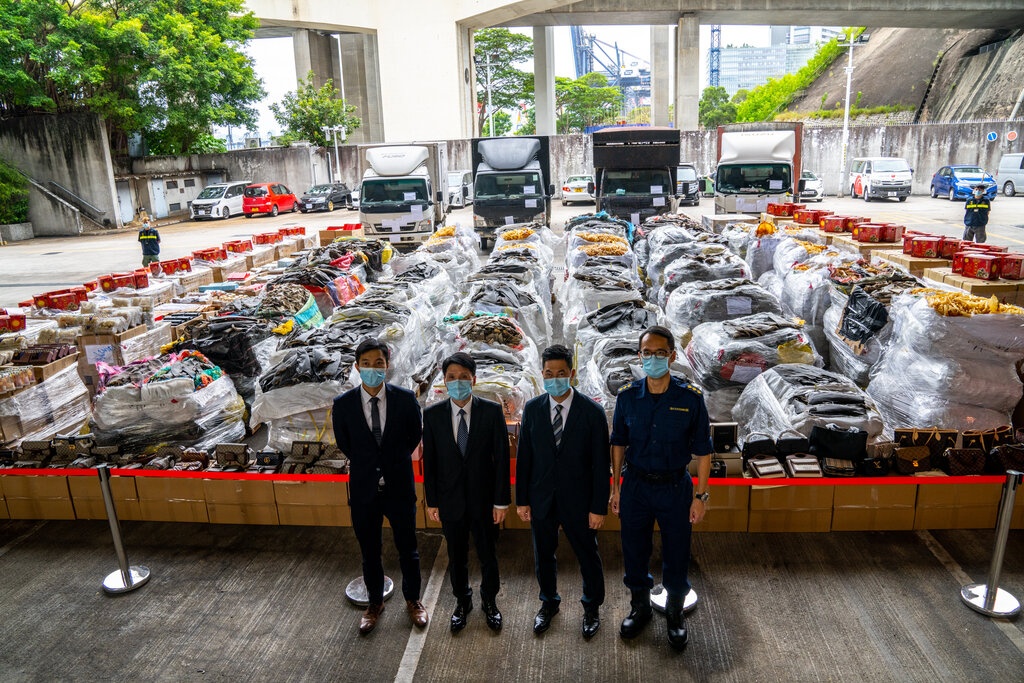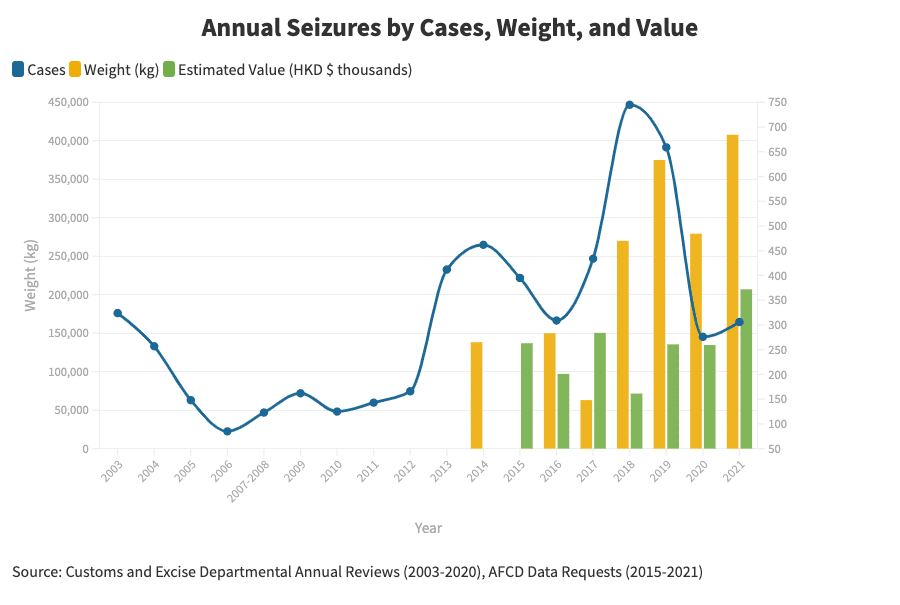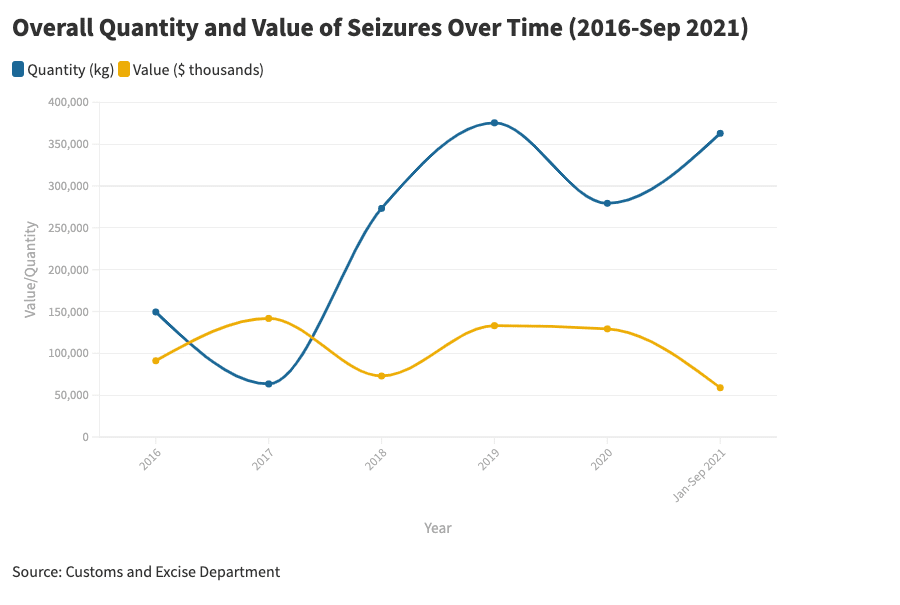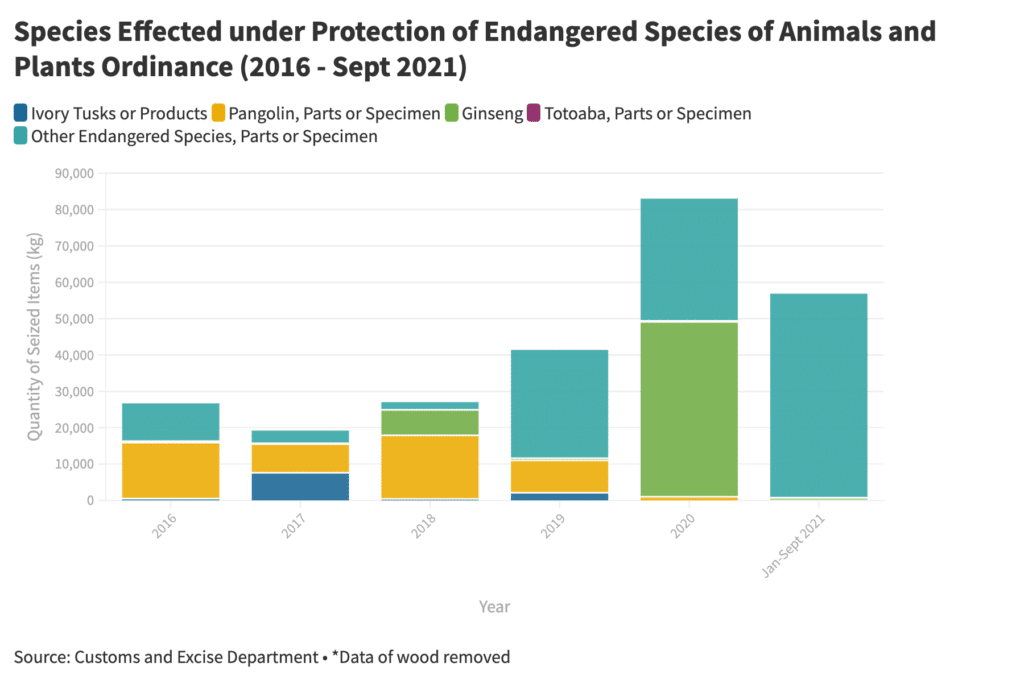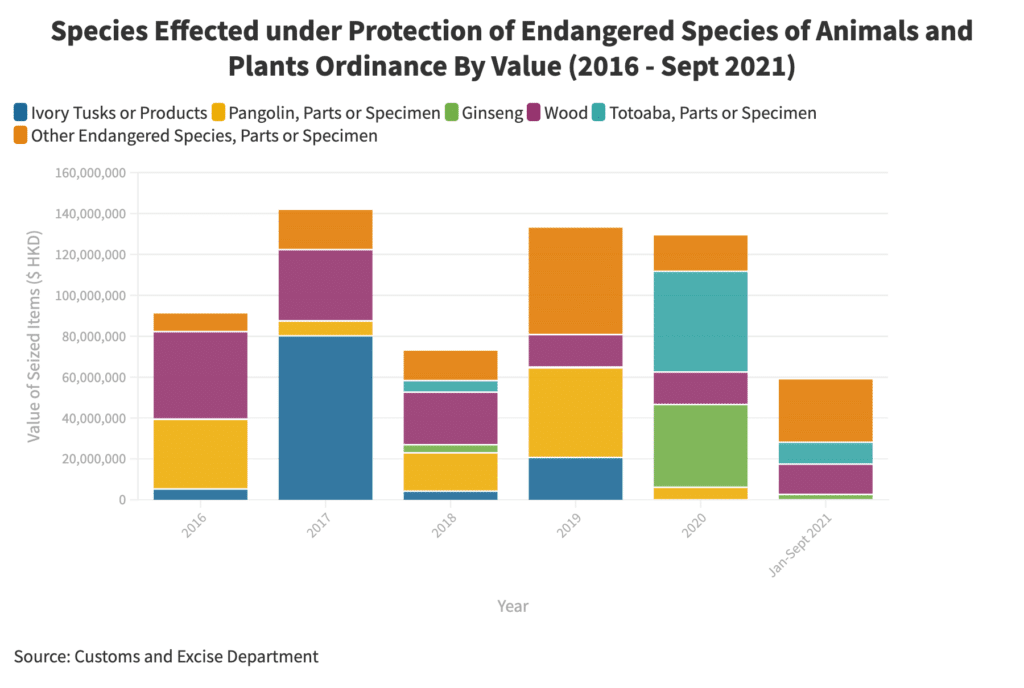On paper, 2021 was a notable year for those fighting Hong Kong illegal wildlife trade, with a historic amendment of the local Organised and Serious Crimes Ordinance (OSCO) and the effects of COVID-19 becoming increasingly visible. However, the data shows that wildlife trafficking has not slowed down, and that the new powers from the OSCO bill amendment have not yet been applied. What will the future hold for this hub of wildlife crime?
—
On September 23, 2021, Hong Kong customs identified its largest-ever smuggling bust with a value of HKD $210 million. Mixed with luxury items, shark fins, and other goods destined for mainland China, the shark fins accounted for over 52% of the total value of goods.
This seizure came one month after a landmark amendment of the Organised and Serious Crimes Ordinance (OSCO) to include wildlife crime, previously reserved for offences of theft, import and export, and money laundering. This meant that authorities are granted greater power to investigate and prosecute illegal wildlife trafficking criminals.
At a Wildlife Task Force meeting in November, in response to a question on if there were any new cases under consideration thanks to the OSCO amendment – including September’s high-value and high-volume seizure – the Agricultural, Fisheries and Conservation Department (AFCD) replied in the negative.
In reaching out for a separate statement, the department confirmed that “as of today (January 20, 2022), the powers of OSCO have not been invoked in enforcement cases handled by the AFCD” but that “the AFCD will stay alert for wildlife trafficking cases where the powers of OSCO can potentially be invoked and ensure that the use of OSCO powers is well justified.” In a separate email, the AFCD also added that they “maintain close contact with the Customs and Excise Department (C&E Department) and Hong Kong Police Force (HKPF) for possible joint investigation if needed.”
“Now, if I’m trying to understand if wildlife crime is an important aspect of organised cross border smuggling, and I make a seizure at a warehouse where 52% of the value of the goods that I’m seizing come from the wildlife product, that to me would be a good indicator that there is a significant incentive for the wildlife component to be […] looked into a bit more,” says Sam Inglis, the Wildlife Programme Manager of the ADM Foundation.
In other words, now that the OSCO bill has been passed, will its powers be applied?

Nearly 10 tonnes of fins were taken from some 15,000 sharks, as part of a record HK$210 million (US$27 million) seizure on September 23, 2021. Photo: Katherine Cheng.
Hong Kong: An Illegal Wildlife Trade Hub
2021 was notable for those fighting Hong Kong’s wildlife trafficking. Experts and proponents had been pushing for the OSCO bill amendment for eight years, making its passage a historic moment. In addition, an ivory trade ban came into effect on December 31, right before the year came to a close.
Wildlife crime is well-known for the difficulties that face authorities, and Hong Kong is notorious as a hub for smuggled goods. As a gateway to mainland China and a historical transportation hub with a throughput of approximately 20 million containers every year, it is known as a bottleneck for illegal wildlife trade routes.
Some of the biggest challenges to stymieing this activity are the many data gaps that pertain to underground crime and the cross-border nature of its movement across different jurisdictions.
Recent Events
As COVID-19 spread across the world, authorities saw an initial global dip in wildlife trafficking as travel plummeted. Experts also noticed a shift towards online trade and suspect that numbers may bounce back – or even increase – as the pandemic and its restrictions ease.
In Hong Kong, despite the global disruption of COVID-19 on transportation routes and increased awareness about the dangers of zoonotic diseases, the data shows that Hong Kong illegal wildlife trade has kept up a sustained flow despite these external circumstances.
The C&E Departmental annual reviews show that though the number of seizure cases decreased by 53.57% between 2021 and 2019, the difference between the total weight of seized goods actually increased by 8.47% from 376,000 kg to 407,860 kg in this same period.
Experts and authorities noticed a shift towards a pattern of larger shipments by containers over the past two years, as air travel and individual travellers decreased with COVID-19 restrictions and smugglers consolidated shipments at greater risk.
However, experts also noted that it is difficult to provide definitive explanations in cases of wildlife crime. With many factors simultaneously at play, changes in seizure data may also reflect a myriad of changes in surveillance frequency and tactics, enforcement capacities, or even chance.
With the available data and estimates of possible trends, it seems that even a global pandemic has not been able to slow down trafficking – in which case, what can we expect moving forward?
Annual Seizures by Cases and Weight
Challenges Moving Forward
Legal procedures are slow moving, and it will take time for the OSCO bill’s change to yield results. In Hong Kong, it is typical for a case to take a year from the point the charges are laid until it is tried. With a backlog of cases given the arrests, Christie Wong, the Wildlife Crime Court Case Monitor of ADM Foundation, expects that the process may take longer.
Barrister and animal-welfare legislation expert Amanda Whitfort from the University of Hong Kong anticipates to see an impact about 12 months after the amendment. “If we don’t start to see them within 18 months, I would be questioning whether it’s being used properly and critiquing some of the decisions that are being made.”
In envisioning the possible ways forward of implementing the OSCO bill, Whitfort and Inglis outlined possible steps such as incorporating training for AFCD staff on the bill’s implications; increasing collaboration between governmental departments for the different divisions to each bring their own strengths; having the C&E Department and/or HKPF lead the change with their existing expertise in tackling related crime.
“The proof is in the pudding as to whether they actually do apply all of those powers,” says Inglis. “They finally have a pretty big sledgehammer.”

Conservation lab at the University of Hong Kong. Photo: Katherine Cheng.
Moving Forward
Truly uncovering the wildlife trafficking pipeline entails changes at all levels.
One example of a group addressing the different aspects of wildlife crime is the Conservation Forensics lab at the University of Hong Kong.
Drawing from a combination of biological science and forensic analyses techniques, the lab supports enforcement efforts in stopping wildlife crime. Using a variety of different tools, they address questions such as identifying what species are involved in trade, origin location of trafficked species, and discerning between captive and wild animals.
From enabling customs officers to identify shark fin and other ocean life through phone apps to using genetics and stable isotope technology to map out species and determine their status of wild-caught or captive-bred, it covers areas of biology, social science, machine learning, and more. The lab’s goal is to use existing tools and apply them to a new context to help solve the issue of wildlife trade.
“I feel like we’re on the brink of something, like big things are gonna happen,” says Tracey-Leigh Prigge, Lab Manager at the University of Hong Kong’s Conservation Forensics Lab and a member of the Society for Wildlife Forensic Sciences Technical Working Group.
With the introduction of the OSCO bill, researchers of the lab are hopeful that there will be an increased recognition of the need for the evidence, data and expertise that the scientific community can provide in order to secure heavier prosecutions.
“I think the main thing that has changed now with the pandemic is that it’s more at the forefront of people’s minds. Consumers are more aware of the risk of zoonotic disease when they’re purchasing wildlife as an exotic pet or luxury cuisine,” says Astrid Andersson, a conservation biologist at the University of Hong Kong and a National Geographic explorer. “And hopefully, governments also have it higher on their priority list. So regulating legal wildlife trade and cracking down on wildlife trafficking, has now become more of a priority.”
As global restrictions from COVID-19 continue to ease and the potential implementation from the OSCO bill amendment approaches, the future of Hong Kong illegal wildlife trade hangs in the balance.
“Remember, with wild species, once they’re gone, they’re gone,” says Whitfort. “And unfortunately, there’s a historical view that animals and plants are not as important as the things that we make, which of course, if COVID has taught us anything, it has taught us that that view is complete nonsense.
The natural world is the most important thing. And the natural world is what is going to see us through or finish us off. And not taking this kind of crime seriously, is at the peril of humans.”
Featured image: Mr. Nelson Chi-Fai Wong (Divisional Commander of Marine Enforcement), Herman Siu-Fai Lui (Divisional Commander of the Special Investigation Division), Mark Wai-Kwan Woo (Head of Syndicate Crimes Investigation Bureau), and Dr. Roger Ho Lee (Endangered Species Protection Officer) pose for a photo for the press in front of the largest seizure ever reported at the Customs and Excise Department of Tsing Yi, Hong Kong on October 7, 2021. Photo: Katherine Cheng
This investigation is part of a series on environmental crime in Asia, supported by the Global Initiative Against Transnational Organized Crime, the Henry Nxumalo Foundation and Oxpeckers Investigative Environmental Journalism.








